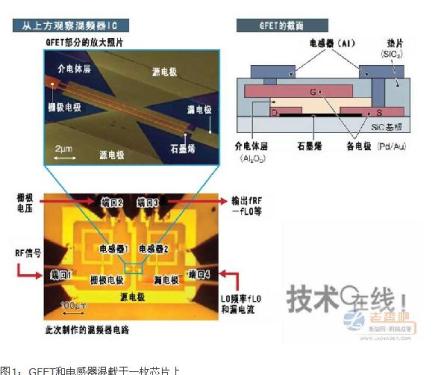 IBM Corp. made mixer ICs using graphene-channel transistors (GFETs). From the formation of the GFET, the stacking to the integration of the inductor and the wiring, all were made on the wafer at one time, demonstrating for the first time the possibility of mass production of ICs using graphene.
IBM Corp. made mixer ICs using graphene-channel transistors (GFETs). From the formation of the GFET, the stacking to the integration of the inductor and the wiring, all were made on the wafer at one time, demonstrating for the first time the possibility of mass production of ICs using graphene. The mixer IC made this time shows a very small characteristic temperature dependence and excellent performance such as large bandwidth operation at 10 GHz. IBM said that the future goal is to mix GFETs in more complex circuits.
Epitaxially growing a mixer on a SiC substrate is a circuit for modulating a frequency in wireless communication. This time, the mixer IC consists of a GFET with a gate length of 550nm, two inductors, and four terminal pads (Fig. 1). The prototype chip size is approximately 900 μm×600 μm.
In the trial production, the graphene film of thermal decomposition was first grown epitaxially on a SiC substrate. Specifically, the surface of the SiC substrate is heated to 1400° C., and Si is desorbed only from the SiC crystals of the 2 to 3 layers on the surface. The remaining C will automatically form a graphene film. The graphene film exhibits the characteristics of an n-type semiconductor.
The figure shows the IBM developed mixer IC. After the graphene was formed by the thermal decomposition method, source/drain electrodes, gate electrodes, and inductors of the wiring layer were sequentially formed. The gate length is 550 nm and the channel width is 30 μm.
A mask was formed on the graphene film, and a pattern was formed on the graphene film using a photolithography technique based on an electron beam (EB). Then, source and drain electrodes are stacked. After forming Al2O3 as a gate insulating film, a gate electrode is formed. Next, an EB is processed into an inductor by superposing an Al layer using a spacer.
When evaluating this trial product, it was confirmed that it could work as designed. That is, when the 4 GHz Local Oscillator (LO) frequency and the 3.8 GHz analog signal are input, the sum of the two frequencies is 7.8 GHz and 200 MHz.
This time, mixer ICs use high-priced SiC substrates, which is a major issue facing their practical application. However, compared to mixer ICs that use GaAs and operate at several GHz, there are still advantages. Because the existing mixer IC cannot be mixed with an inductor, external passive components are required.
Modern Physics Experiment Series
Modern physics experiment related equipment for efficient specialized physics laboratory
Modern Physics Experiment Instruments,Optical Instruments,Acousto-Optic Modulator Experimental Device,Optical Spectroscopy Experiment Determinator
Yuheng Optics Co., Ltd.(Changchun) , https://www.yhenoptics.com